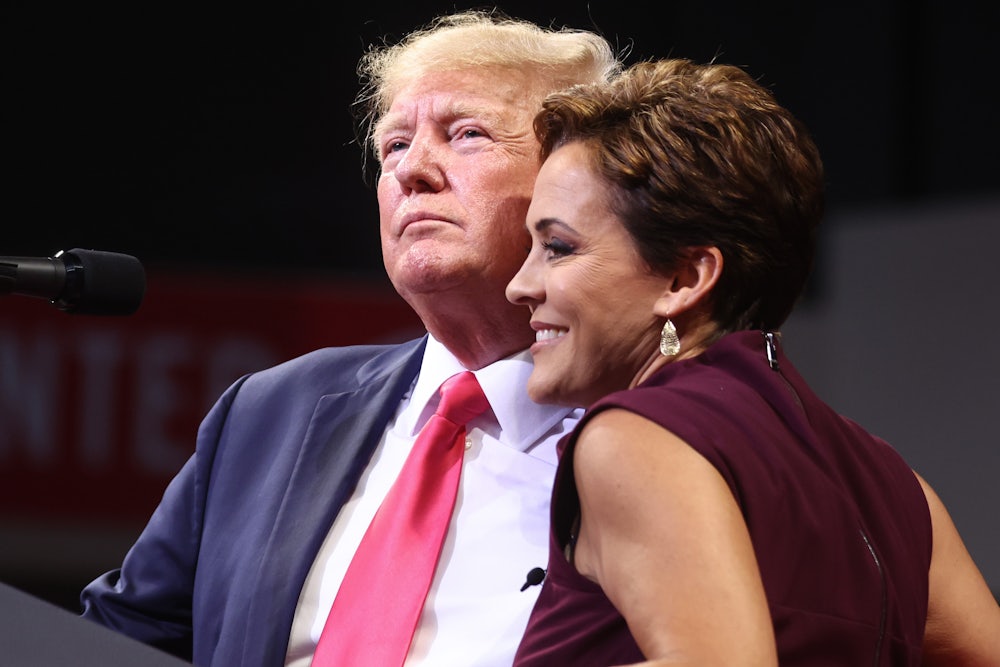Ever since voters in red states like Kansas and Ohio turned out in droves in 2022 and 2023 to protect abortion rights in their states, some in the Democratic Party have hoped abortion ballot measures in swing states might increase turnout and shift the course of this year’s election. Ten states have abortion measures on the ballot this year—including swing states like Florida and Arizona. But last month, a New York Times/Siena College poll from Arizona disrupted this narrative: Likely voters’ support for Harris, at 45 percent, seemed to be trailing support for the state’s abortion rights ballot measure, at 58 percent. These numbers may seem surprising to those who hoped ballot measures would boost Democratic turnout, but they reflect a broader reality: Legal abortion is more popular than Democrats are.
For those who research and run ballot measure campaigns, the Arizona polling is not an unusual finding. Since 2021, Benjamin Case has led ballot initiative research at the Center for Work and Democracy, a labor-funded research center at Arizona State University. “Pretty consistently, we see results where people will vote differently when they’re allowed to vote on a policy versus when they have to vote for a politician as a proxy for all their views on different policies,” said Case. “The conventional wisdom was that abortion was this polarizing issue that splits the country down the middle,” said Case. But “one of the things that allowed that misperception to survive was the fact that voters weren’t really asked very often directly.”
Kansas broke this dynamic open when anti-abortion groups working alongside the Republican-led state legislature rushed a ballot measure ending abortion rights in front of voters, months after Dobbs. Kansas voters rejected it firmly; and in some counties that Trump had won in 2020, though the ballot measure lost, the margins were much closer than Trump’s margin. Then came Ohio in 2023: Voters passed, 57 to 43 percent, a constitutional amendment to protect legal abortion. “The scope of the victory for the Yes side suggests that a significant number of Republicans voted in favor,” according to an AP analysis. It wasn’t universal: 44 counties Trump had won by 70 percent or more in 2020 voted against protecting abortion rights. But nine out of the 10 counties where Trump won by 60 percent or less in 2020 voted “yes” on the abortion rights measure. It appeared that some Trump voters were “flipping.”
Such results helped fuel the notion that abortion rights ballot measures were good for Democrats: They might increase Democratic turnout, benefiting not only the presidential race but downballot Democrats. The numbers looked strong after Ohio and heading into the 2024 election. “The abortion rights position has over-performed Democrats’ presidential vote share by an average of nine points since 1970,” noted a Washington Post story on a recent Ballotpedia analysis. “But in 5 of 7 cases post-Roe, it has over-performed by double digits.” Another way of looking at those figures is that abortion rights were more popular than some Democratic candidates for president.
“The very existence of my organization,” said Kelly Hall, executive director of the Fairness Project, “is evidence that there is a gap between people’s partisan affiliations and how they are willing to vote on specific issues when they’re brought to them as ballot measures.” The group is nonpartisan, and provides strategy and communications support to state-based ballot measure campaigns. Given what they have seen, Hall said she’s “pretty dubious of those turnout arguments” about the measures boosting Democrats. Those arguments get a lot of attention because the press focuses on the Republican and Democrat horse race, Hall said. “They try to fit everything in the political landscape into that box.”
The Arizona poll showing Harris at 45 percent and the state’s abortion rights ballot measure at 58 percent, while a good reality check, isn’t necessarily a reason for Harris supporters to panic: To start, the poll has a margin of error of 4.4 percent, meaning the Harris support might be nearer to the 50 percent support for Trump. It’s also just one poll; a new one released this week puts Harris just two points behind Trump in the state.
The Arizona case is particularly complex, and not easy to capture in polls. Overall, two-thirds of the state’s women voters say they support abortion until presumed fetal viability, as the ballot measure proposes, according to a KFF poll of women voters published in June. That includes 68 percent of independents in a state where voters who list no party affiliation have at times outnumbered those registered Republican or Democrat. Six in 10 Democratic women voters said they would be more motivated to vote with an abortion rights measure on the ballot, along with 52 percent of independent women voters—indicating some potential impact on turnout.
It’s not just independents; there’s substantial support for the ballot initiative among Republicans. About four in 10 Republican women voters in Arizona said they support the ballot initiative—perhaps not that surprising, since nationwide, about half of Republican women voters believe abortion should be legal in all or most cases. (The Harris campaign has also been courting Republicans, for example sending surrogates out to “Republicans for Harris” campaign events in Arizona, specifically on the issue of abortion rights.) What this reflects is that when voters are asked directly to vote on a policy, their votes don’t necessarily align with those of the politicians they also vote for.
But what should we make of the four in 10 women voters in Arizona who said they would vote for Kari Lake for Senate and yet also support the ballot measure? Lake has backed laws banning abortion over the course of her political career, has praised a near-total abortion ban, and still denies that she and Trump lost their last elections. At first, these numbers can seem shocking, or lend themselves to hopes that those Lake voters could be flipped if only they had the “right” information.
“The shocking thing to me,” Kelly Hall said, “is the number of Arizona voters who believe that Joe Biden was to blame for the fall of Roe, because it happened on his watch—the number of folks who do not pay attention to this for a living, who don’t fundamentally understand that there is a major difference between the parties on this issue.” In Arizona, according to a May 2024 Times/Siena poll, around 16 percent of registered voters said that Biden bears a lot or some responsibility “for the Supreme Court ending the constitutional right to abortion.” (Fifty-six percent said it was Trump’s responsibility.) On this question, the Arizona voters were in line with those in other swing states, where on average, 17 percent of voters blamed Biden for the end of Roe, including 12 percent of Democrats.
“There is actually not as deep and well-worn a connection between ‘Democrats are good on this issue and agree with me, and Republicans are not’ as folks in D.C. and the coast would like to believe,” Hall continued. And some Republican candidates, including Donald Trump, who claims he merely “returned abortion to the states,” are working to muddy that distinction. “It is the job of the Democratic Party, if they want to take it on, to draw that distinction,” Hall said.
The problem of voter information goes deeper than just what voters know or don’t know about where candidates stand on abortion, though. In a state like Arizona, where the legality of abortion has remained in flux—bans came into effect, and were blocked—many voters this year may not know if abortion is legal or not. (It is—up to 15 weeks.) Another KFF survey, conducted this spring, found that among women of reproductive age, only 21 percent knew that in their state abortion was legal, but only earlier in pregnancy. In light of this, the ballot measure campaigns might also serve as political education, and in a way that electoral campaigns do not. Abortion ballot measure campaigns are a way to let people know what the status quo is, and what would change if the measure passes.
Mobilizing voters for abortion rights is a different project from electing Democrats. In fact, ballot measures give voters an opportunity to divorce their vote for abortion rights from their votes for any particular candidate; that opportunity may be precisely what motivates them to turn out and vote in an election where they aren’t enthusiastic about their candidate options. Having both approaches open to voters—the ability both to elect candidates they hope will do right by them, and also the ability to directly vote for the policies they want—Hall said, is “a net positive—a very good thing.”








